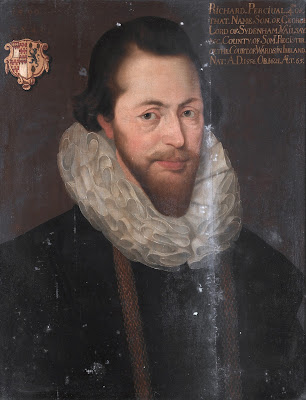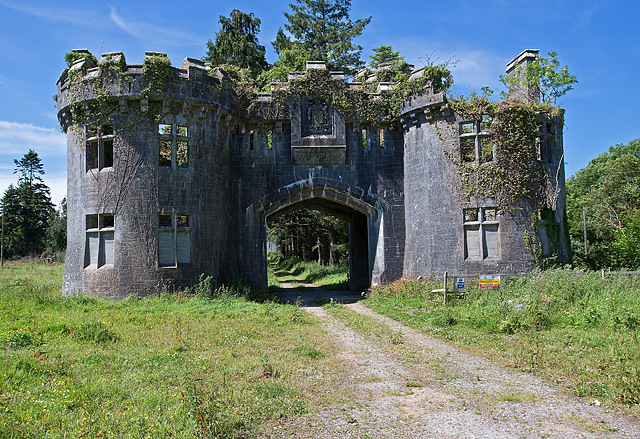THE EARLS OF EGMONT WERE MAJOR LANDOWNERS IN COUNTY CORK, WITH 16,776 ACRES
The ancient and illustrious house of PERCEVAL is supposed, by many suggestive circumstances, to take its origin from a younger branch of the sovereign Dukes of Brittany in France; out of which province they were transplanted to Normandy before its conquest, and were invested with the hereditary office of Chief Butlers of that duchy.
GEOFFREY I, Duke of Brittany, had a younger son,
ODO or EUDES, Viscount of Porhoët, at length Duke of Brittany, who a little before the Conquest left issue, by his wife Agnes, among other sons, one named
ROBERT, presumed the same with Robert, Lord of Yvery, the first of his family that settled in England upon the Norman conquest.
*****
DAVID PERCEVAL, Lord of Twickenham, Rolleston, Somerset (lineally descended from Ascelin Gouel de Perceval, who accompanied THE CONQUEROR to England), married Alice, daughter of Thomas Bythemore of Overwere.
He died in 1534, and left issue,
James, dsp 1548;The second son,
GEORGE, of whom presently;
Thomas.
GEORGE PERCEVAL (c1532-c1601), Lord of Twickenham, wedded Elizabeth, daughter of Sir Edward Bamfylde, of Poltimore, in Devon; and dying about 1599, left, with a daughter Elizabeth, a son,
 |
| Richard Perceval (Wikipedia) |
RICHARD PERCEVAL (1550-1620). The life of this ultimately successful person was chequered and eventful in no ordinary degree.
He was educated at St Paul's School, then the most celebrated seminary in England, whence he was sent to Lincoln's Inn, to acquire some general idea of the laws, esteemed, in those days, an accomplishment of the highest description.
In both his progress was brilliant, but his conduct dissipated and disorderly, so much so indeed, that he incurred the displeasure of his father, who, upon his marriage with Joan Young, entirely abandoned him, observing, that as he had ruined himself by his riots, he might recover himself by his wits.
Thus unnaturally cast off, Mr Perceval found means, by the credit of his reversionary estates, and the assistance of his friends, to maintain himself several years, during which time he three sons and two daughters: but at length, through a failure of resources, and the increasing expenses of his family, he was obliged to quit the kingdom, and travelled into Spain, where he remained about four years.
Being then informed of his wife's decease, he returned to England, hoping, now that principal cause of his father had been removed, he might again recover his good opinion; but that hope proving delusive.
Having subsequently filled the office of Secretary of the Court of Wards in England, for several years, he was nominated in 1616, Registrar of the Court of Wards in Ireland, where, after obtaining considerable landed property, he died and was succeeded by his son (by his second wife),
SIR PHILIP PERCEVAL (1605-47), Knight, a very distinguished statesman, who, having been actively employed in the government of Ireland for a series of years, obtained grants of forfeited lands there to the extent of 101, 000 acres.
He wedded Catherine, granddaughter of Sir William Usher, Clerk of the Council, and daughter of Arthur Usher by his wife, Judith, daughter of Sir Robert Newcomen, of Moystown, County Longford, and had issue,
SIR JOHN PERCEVAL (1629-65), Knight, was created a baronet in 1661, by patent, containing this remarkable clause that, "the eldest son, or grandson, shall exist a baronet, after the age of 21 years, at the same time with the father or grandfather."
His great-grandson,
THE RT HON SIR JOHN PERCEVAL (1683-1748), who, after becoming a privy counsellor, and sitting for several years in the Irish House of Commons, was elevated to the peerage of that kingdom, by patent, in 1715, as Baron Perceval.
He was educated at St Paul's School, then the most celebrated seminary in England, whence he was sent to Lincoln's Inn, to acquire some general idea of the laws, esteemed, in those days, an accomplishment of the highest description.
In both his progress was brilliant, but his conduct dissipated and disorderly, so much so indeed, that he incurred the displeasure of his father, who, upon his marriage with Joan Young, entirely abandoned him, observing, that as he had ruined himself by his riots, he might recover himself by his wits.
Thus unnaturally cast off, Mr Perceval found means, by the credit of his reversionary estates, and the assistance of his friends, to maintain himself several years, during which time he three sons and two daughters: but at length, through a failure of resources, and the increasing expenses of his family, he was obliged to quit the kingdom, and travelled into Spain, where he remained about four years.
Being then informed of his wife's decease, he returned to England, hoping, now that principal cause of his father had been removed, he might again recover his good opinion; but that hope proving delusive.
Having subsequently filled the office of Secretary of the Court of Wards in England, for several years, he was nominated in 1616, Registrar of the Court of Wards in Ireland, where, after obtaining considerable landed property, he died and was succeeded by his son (by his second wife),
SIR PHILIP PERCEVAL (1605-47), Knight, a very distinguished statesman, who, having been actively employed in the government of Ireland for a series of years, obtained grants of forfeited lands there to the extent of 101, 000 acres.
He wedded Catherine, granddaughter of Sir William Usher, Clerk of the Council, and daughter of Arthur Usher by his wife, Judith, daughter of Sir Robert Newcomen, of Moystown, County Longford, and had issue,
JOHN, his heir;Sir Philip was succeeded by his eldest son,
George, father of PHILIP.
SIR JOHN PERCEVAL (1629-65), Knight, was created a baronet in 1661, by patent, containing this remarkable clause that, "the eldest son, or grandson, shall exist a baronet, after the age of 21 years, at the same time with the father or grandfather."
His great-grandson,
THE RT HON SIR JOHN PERCEVAL (1683-1748), who, after becoming a privy counsellor, and sitting for several years in the Irish House of Commons, was elevated to the peerage of that kingdom, by patent, in 1715, as Baron Perceval.
His lordship wedded, in 1710, Catherine, daughter of Sir Philip Parker Bt, and had issue,
JOHN, his successor;Philip;George;Catherine; Anne; Mary; Helena.
 |
| John, 1st Earl of Egmont (Wikipedia) |
His lordship was advanced to a viscountcy, in 1722, as Viscount Perceval, of County Cork, with the annual fee of twenty marks, payable out of the Exchequer, attached, to support the honour.
In 1732, this nobleman obtained a charter to colonise the province of Georgia, in America, and being nominated president thereof; and was further advanced to the dignity of an earldom, in 1733, as EARL OF EGMONT.
His lordship was succeeded by his eldest son,
JOHN, 2nd Earl (1711-70), who married twice, and had sixteen children, of which his eldest son,
JOHN JAMES, 3rd Earl (1738-1822), espoused, in 1765, Isabella, daughter of Lord Nassau Powlett (son of Charles, 2nd Duke of Bolton), and had issue, an only child,
JOHN, 4th Earl (1767-1835), who married, in 1792, Bridget, daughter of Glyn Wynn, and had issue, an only child,
HENRY FREDERICK JOSEPH JAMES, 5th Earl (1796-1841), who wedded, in 1828, Louisa Maria, daughter of Comte D'Orselet, and had issue, an only child, who died in infancy; when the titles reverted to his cousin,
GEORGE JAMES, 6th Earl (1794-1874), third but eldest surviving son of Charles, 2nd Baron Arden (eldest son of John, 2nd Earl of Egmont), who espoused, in 1819, Jane, daughter of John Hornby; the marriage, however, was without issue, when the titles devolved upon his lordship's nephew,
CHARLES GEORGE, 7th Earl (1845-97), DL, MP, grandson of the 2nd Baron Arden, who married, in 1869, Lucy, daughter of Henry King; the marriage, however, was without issue, when the titles reverted to his cousin,
AUGUSTUS ARTHUR, 8th Earl,
- Augustus Arthur Perceval, 8th Earl (1856–1910);
- Charles John Perceval, 9th Earl (1858–1929) (dormant);
- Frederick Joseph Trevelyan Perceval, de jure 10th Earl (1873–1932);
- Frederick George Moore Perceval, 11th Earl (1914–2001) (claim admitted 1939);
- Thomas Frederick Gerald Perceval, 12th Earl (1934–2011).
Following the death of the 12th and last Earl the titles became extinct.
 |
| Photograph by Mike Searle. Some rights reserved. (view image details) |
LOHORT CASTLE is near Cecilstown, County Cork.
This historic castle is an impressive five-storey fortified tower with rounded corners, standing over eighty feet tall.
The massive walls are ten feet thick at the base, narrowing to six feet.
Around the top storey there is a machicolated parapet that runs unbroken apart for a short section on the eastern side.
There used to be a deep moat around the castle with a drawbridge.
The castle grounds cover more than one hundred acres.
Lohort Castle was built ca 1496 by Donogh Og McDonagh McCarthy.
The castle was taken by the Irish forces during the civil war.
One of the bloodiest battles of the English civil war took place in the grounds of Lohort Castle in 1647, when over 4,500 men were killed in battle.
Lohort was bombarded by Oliver Cromwell's troops in 1650 and captured, but the castle withstood the cannon fire due to the immense strength of its thick walls.
 |
| Lohort Castle Gatehouse |
The castle as it now stands was rebuilt ca 1750 by Sir John Perceval, 1st Earl of Egmont, and the Percevals lived there until the 20th century, when it was burnt by the IRA in 1922.
Some of the fireplaces from nearby Kanturk Castle appear to have been relocated to Lohort Castle; this was probably done when Lohort Castle was restored in the 18th century.
Lohort subsequently became the home of Sir Timothy O'Brien Bt, a well-known cricketer.
First published in August, 2012. Egmont arms courtesy of European Heraldry.



No comments :
Post a Comment